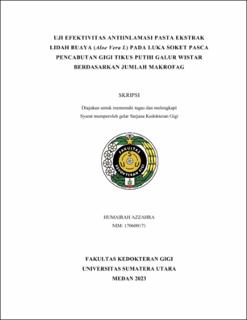| dc.description.abstract | Wounds that occur due to tooth extraction and surgery will undergo a wound healing
process. Wound healing stages are divided into 3 phases, namely inflammation,
proliferation and remodeling. Inflammation is a protective mechanism of the body that
seeks to neutralize and eradicate harmful agents in the injured area and prepares for
tissue repair. Macrophages are the most dominant cells in inflammation with the
highest number on the 3rd day and are distributed in most of the connective tissue. Aloe
vera (Aloe vera L) is one of the herbal plants that can help the inflammatory process.
This study aims to determine the anti-inflammatory effectiveness of aloe vera paste
extract (Aloe vera L) with concentrations of 25%, 50%, and 75% on the number of
macrophage cells in socket wounds after tooth extraction in Wistar white rats. The
samples used were 48 rats that had been acclimatized and then the teeth of Wistar rats
were extracted on the left incisor of the lower jaw then aloe vera paste extract (Aloe
vera L) was applied with concentrations of 25%, 50% and 75% in the treatment group
and basic paste administration. In the control group, tissue samples were taken using
Hematoxylin Eosin (HE) examination to see the number of macrophage cells. Data
processing was analyzed using the Shapiro Wilk test followed by a one way ANOVA
test. The results showed that there was a significant average difference in the number
of macrophages produced by each negative control group with basic paste
administration and the treatment group with Aloe vera extract (p<0.05). The conclusion of this study is that aloe vera paste extract (Aloe vera L) with concentrations of 25%,
50%, and 75% has an anti-inflammatory effect on decreasing the number of
macrophage cells in post-tooth extraction socket wounds. This research is a laboratory
experimental study with a post test only control group research design. | en_US |


